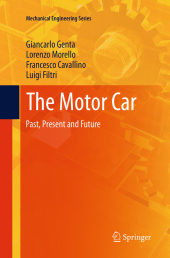 Neuerscheinungen 2016Stand: 2020-02-01 |
Schnellsuche
ISBN/Stichwort/Autor
|
Herderstra▀e 10
10625 Berlin
Tel.: 030 315 714 16
Fax 030 315 714 14
info@buchspektrum.de |

Francesco Cavallino, Giancarlo Genta, Lorenzo Morello
(Beteiligte)
The Motor Car
Past, Present and Future
Softcover reprint of the original 1st ed. 2014. 2016. xxiv, 662 S. 418 Farbabb. 235 mm
Verlag/Jahr: SPRINGER NETHERLANDS; SPRINGER 2016
ISBN: 9401779554 (9401779554)
Neue ISBN: 978-9401779555 (9789401779555)
Preis und Lieferzeit: Bitte klicken
This undergraduate textbook offers an introduction to automotive engineering. It covers all aspects of present automotive technology, describes the historical evolution of the technology, and supplies tools to analyze vehicle performance.
This book is an introduction to automotive engineering, to give freshmen ideas about this technology. The text is subdivided in parts that cover all facets of the automobile, including legal and economic aspects related to industry and products, product configuration and fabrication processes, historic evolution and future developments.
The first part describes how motor vehicles were invented and evolved into the present product in more than 100 years of development. The purpose is not only to supply an historical perspective, but also to introduce and discuss the many solutions that were applied (and could be applied again) to solve the same basic problems of vehicle engineering. This part also briefly describes the evolution of automotive technologies and market, including production and development processes.
The second part deals with the description and function analysis of all car subsystems, such as:
˙ vehicle body,
˙ chassis, including wheels, suspensions, brakes and steering mechanisms,
˙ diesel and gasoline engines,
˙ electric motors, batteries, fuel cells, hybrid propulsion systems,
˙ driveline, including manual and automatic gearboxes.
This part addresses also many non-technical issues that influence vehicle design and production, such as social and economic impact of vehicles, market, regulations, particularly on pollution and safety.
In spite of the difficulty in forecasting the paths that will be taken by automotive technology, the third part tries to open a window on the future. It is not meant to make predictions that are likely to be wrong, but to discuss the trends of automotive research and innovation and to see the possible paths that may be taken to solve the many problems that are at present open or we can expect for the future.
The book is completed by two appendices about the contribution of computers in designing cars, particularly the car body and outlining fundamentals of vehicle mechanics, including aerodynamics, longitudinal (acceleration and braking) and transversal (path control) motion.
Economic figures.- Vehicle and parts manufacturers.- Impact on economy.- Product development and marketing.- Vehicle diffusion.- Regulations.- Type approval and production conformity.- Environmental protection.- Occupants and pedestrians safety.- Body.- Body in white.- Interiors.- Body systems.- Chassis.- Tire.- Suspension.- Steering system.- Braking system.- Powertrain mounts.- Transmission.- Powertrain.- ICE working cycles.- ICE design.- ICE ancillaries.- Manual gearboxes.- Automatic gearboxes.- Full electric powertrains.- Hybrid powertrains.- Production systems and materials and materials.- Steel mill.- Body presswork.- Body welding.- Body painting.- Iron and aluminum foundry.- Plastic materials.- Fuels and lubricants.- Body.- Separated body.- Unitized body.- Body systems.- Vehicle architecture.- Future developments.


